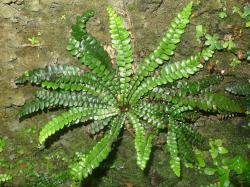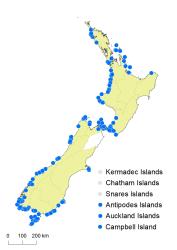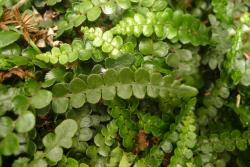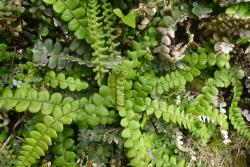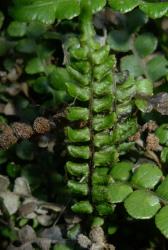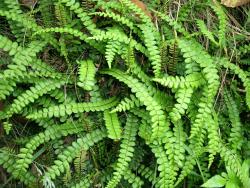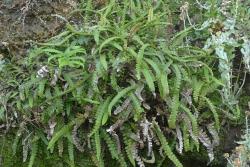- ≡ Lomaria banksii Hook.f., Bot. Antarct. Voy. II (Fl. Nov.-Zel.) Part II, 31, t. 76 (1854)
- ≡ Spicanta banksii (Hook.f.) Kuntze, Revis. Gen. Pl. 2, 821 (1891)
- ≡ Austroblechnum banksii (Hook.f.) Gasper & V.A.O.Dittrich in Gasper et al., Phytotaxa 275: 202 (2016)
Rhizomes erect or suberect, up to 60 mm long (in herbarium material), bearing scales. Rhizome scales ovate to narrowly ovate, 5–10 mm long, 1–3 mm wide, chestnut-brown, concolorous. Fronds strongly dimorphic; sterile fronds 35–500 mm long, forming a prostrate to suberect rosette; fertile fronds on same plant usually shorter, 25–400 mm long, sometimes only half the length of the sterile fronds, positioned centrally, held erect. Sterile fronds. Stipes 5–80 mm long, red-brown, bearing a few scales proximally. Rachises yellow-brown, grooved adaxially, glabrous. Laminae 30–440 mm long, 5–40 mm wide, rarely to 50 mm wide, pinnatisect, linear to narrowly obovate, tapering to a pinnatifid apex, dark green adaxially, paler green abaxially, slightly fleshy, glabrous. Pinnae in 7–40 pairs, closely spaced, triangular or oblong or suborbicular, straight, gradually reducing to short, wide flanges at the lamina base; the longest pinnae at or above the middle, 5–27 mm long, 3–13 mm wide, apices obtuse to rounded, margins entire or shallowly crenate, bases adnate; the basal pinnae alternate. Veins free. Fertile fronds. Stipes 5–80 mm long. Laminae 20–310 mm long, 4–40 mm wide. Pinnae in 7–40 pairs, linear to narrowly oblong or narrowly triangular, usually falcate or rarely straight, the longest 5–23 mm long, 1–4 mm wide, replaced by shorter sterile flanges at the lamina base. Sori and indusia in one row either side of costa, continuous along the length of the pinna.
Blechnum banksii is distinguished by its dimorphic fronds, free veins, pinnatisect sterile laminae, and continuous sori. It is exclusively coastal in habitat, and has slightly fleshy fronds. The sterile laminae are linear to narrowly obovate, with triangular to orbicular pinnae that are rounded to obtuse at their apices, entire or slightly crenate on their margins and adnate at their bases. The basal pinnae are arranged alternately. The laminae are glabrous and darker green on their adaxial surfaces, and the fertile fronds are generally shorter than the sterile.
Blechnum banksii is likely to be confused only with B. chambersii or B. durum, both of which occur in coastal habitats. Compared to B. chambersii, its sterile laminae are narrower (5–40 mm wide, cf. 15–110 mm wide) and more fleshy. It can be distinguished from B. durum by its smaller sterile laminae (30–440 mm long, 5–40 mm wide, cf. 140–650 mm long, 22–115 mm wide), less crowded fertile pinnae and concolorous rhizome scales that lack black margins.
North Island: Northland, Auckland, Volcanic Plateau, Gisborne, Taranaki, Southern North Island.
South Island: Western Nelson, Sounds-Nelson, Westland, Canterbury, Otago, Southland, Fiordland.
Stewart Island, Antipodes Island, Auckland Islands, Campbell Island.
Altitudinal range: 0–200 m.
Blechnum banksii occurs in coastal habitats from the Aupouri Peninsula, Northland, down the west coast to Wellington, and into the Bay of Plenty as far as East Cape, but is absent from eastern Northland and the east coast between East Cape and Cape Palliser. It grows in the immediate vicinity of the sea, reaching 120 m on Auckland’s west coast. In the South Island it extends from the Marlborough Sounds to north-west Nelson, along the west coast, and around the south coast as far as Dunedin. There is an outlying population on Banks Peninsula, but it is otherwise absent from the Marlborough and Canterbury coastlines. It reaches 190 m on the Otago Peninsula, and c. 200 m near Port Pegasus, Stewart Island. It extends to Stewart, Auckland and Campbell Islands, but is apparently absent from the Chatham Islands.
Also Chile.
Blechnum banksii is a terrestrial fern confined to damp rocks, overhangs, rock crevices, shaded seepages, or stream banks close to the sea, and is classified as a salt-spray species (Chambers & Farrant 1996). It often grows under Coprosma repens, Brachyglottis rotundifolia, Veronica elliptica, Phormium species, or Olearia scrub, and is frequently associated with Asplenium obtusatum or, in the far south, with Blechnum durum. In the subantarctic it occurs in Poa litorosa tussock. It grows more abundantly and luxuriantly on the west coast and in the far south.
A possible hybrid between Blechnum banksii and B. chambersii has been collected from South Westland, Ship Creek, south of Tauperikaka Point, D.R. Given 127012, CHR 420408. No spores are present to confirm the hybrid nature of the plant.
2n = 66 (Chambers 1954; Chambers & Farrant 1996).
Chambers & Farrant (1996) suggested that plants referred to Blechnum banksii, based on New Zealand material, and B. blechnoides and B. leyboldtianum (Phil.) C.Chr., based on Chilean material, all belonged to the same taxon. The name they used for this taxon was “Blechnum blechnoides (Bory) Keyserl.”. However, the basionym, Lomaria blechnoides Bory, is illegitimate, being a later homonym of Lomaria blechnoides Desv. Blechnum blechnoides Keyserl. is a nomen novum (Art. 58.1, Ex. 1), and legitimate, but dates from 1873, and is therefore a more recent name than either B. banksii published in 1854, or B. leyboldtianum published in 1861. Although Chambers & Farrant (1996) regarded New Zealand and Chilean material as conspecific, Rodríguez Ríos (2015) suggested that the plants in the two areas are morphologically rather different, and that they should be recognised as B. banksii in New Zealand and B. leyboldtianum in Chile. However, neither author provided quantitative morphological evidence for their conclusions, and further investigation is needed to determine the status of these taxa. Regardless of the outcome, the correct name for the plant in New Zealand is B. banksii, and because material in the two countries is superficially similar, we treat the species in New Zealand as non-endemic until definitive evidence is produced to the contrary.



